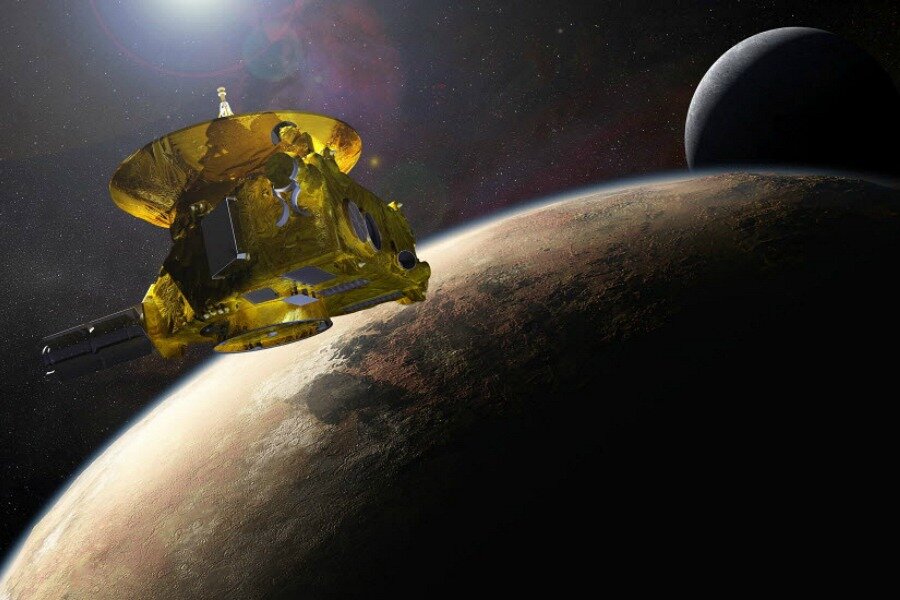New Horizons closes on dwarf planet: Is Pluto ready for its close-up?
Loading...
| Laurel, Md.
In less than two days, NASA's New Horizons spacecraft is set to give humanity its most intimate look yet at Pluto and its moons – a historic flyby that closes one chapter in humanity's efforts to explore the solar system even as it opens another.
Pluto is the last of the solar system's nine classical planets targeted for at least a flyby mission. Indeed, Pluto – now classified as a dwarf planet – and its largest moon Charon make up the solar system's only known binary planet.
But Pluto also is the largest body in the Kuiper Belt, a band of icy objects that extends far beyond Neptune. Thus, Pluto also represents the first encounter with an object at the doorstep of this enigmatic region of the solar system.
The $720-million, don't-blink-or-you'll-miss-it mission is traveling right down the line after a final course adjustment June 29.
"Everything's going great," said Glen Fountain, the mission's project manager at the Johns Hopkins University's Applied Physics Laboratory (APL) in Laurel, Md., on Sunday. The mission's scientists "are really having a great time seeing the data as it comes down."
New Horizons began its formal sequence of flyby observations on July 7, while it was still 5 million miles from the Pluto-Charon system. Now it's closing to within 1 million miles of the system.
One of the mission's three primary goals is to provide detailed color images of Pluto and its moons.
"We're sick of seeing pixelated blobs," says Hal Weaver, the mission's project scientist. "We're going to turn Pluto into a real world with complexity and diversity."
That's already happening. The latest images of Pluto released to date, beamed back on Friday and Saturday, reveal a region of jumbled terrain roughly 1,000 miles long, what appear to be large craters, and three Missouri-size patches of dark material in Pluto's equatorial region. They appear to be linked to a belt of dark material that spans the rest of the equatorial region.
These dark regions may represent complex hydrocarbons that formed as cosmic rays, the sun's ultraviolet radiation, or the solar wind – charged particles constantly streaming from the sun – interacted with nitrogen, carbon monoxide, and methane ices on Pluto's surface, Dr. Weaver suggests.
"It looks like a very rich environment" on Pluto and on Charon, he says.
The views New Horizons has been delivering so far focus on a different hemisphere than the one the craft will record during Tuesday's closest approach. Beamed back on Saturday, the image revealing the dark patches represents "the last, best look that anyone will have of Pluto’s far side for decades to come," noted Alan Stern, a planetary scientist at the Southwest Research Institute in Boulder, Colo., and the mission's lead scientist, in a statement over the weekend.
Researchers will combine the black-and-white image, taken while the craft was 2.5 million miles from Pluto, with color images and data on surface composition the craft also has gathered. When combined, these data while help mission scientists reconstruct the geologic history of that hemisphere.
The images are serving as a teaser for the main show, which will last for about 24 hours, centered around the closest encounter at 7:49 A.M. EDT Tuesday.
During the last 12 hours inbound, New Horizons is slated to take ultraviolet measurements of Pluto's atmosphere. It also will take data that will yield topographic maps of Pluto and its moons as well as maps of their surface composition.
The mission's heaviest lifting will come during a half-hour period around closest approach, when New Horizons zips past Pluto at 31,000 miles an hour and some 7,750 miles above the surface. The craft will be taking the most detailed images of Pluto and Charon, mapping features as small as a football field. Mapping the surface composition also will continue and in greater detail.
The second major goal is to characterize Pluto's atmosphere and see if Charon has one. Outbound, the craft is programmed to look back at the Pluto-Charon system using experiments designed to analyze the composition and temperature distribution of Pluto's atmosphere. The science team will use powerful radio signals beamed from Earth to measure these properties in Pluto's lower atmosphere. An ultraviolet spectrometer on New Horizons will take advantage of sunlight to "backlight" the upper atmosphere and reveal its chemical constituents.
These approaches also will be used to see if Charon has an atmosphere. The craft will also use the backlighting from the sun to look for any tenuous rings around the system.
New Horizon's flyby sequence is pre-programmed. Radio signals take 4-1/2 hours to reach the craft and the opportunity to make the measurements is fleeting, rendering useless any attempt on the part of ground controllers to adjust the program on the fly – especially at the rapid-fire pace at which the craft will be operating during closest approach.
The team is confident enough in the craft's performance in executing the commands that cheers and high fives are likely to erupt Tuesday morning, even though controllers will have received no indication of what's happening 3 billion miles away, Dr. Stern noted in a briefing Sunday.
New Horizons' communications antenna is fixed to the craft, so the craft must reorient itself to properly aim the antenna at Earth. Any attempt to communicate with Earth during the flyby's most critical period would mean pulling the instruments off their targets.
So back on Earth, mission controllers will be awaiting a brief burst of telemetry slated to arrive during a 16-minute window Tuesday evening. This burst will contain the only spacecraft-status update controllers will receive during the flyby's most critical period.
"It will be intense," says Alice Bowman, the mission's operations manager at APL, of the wait.






